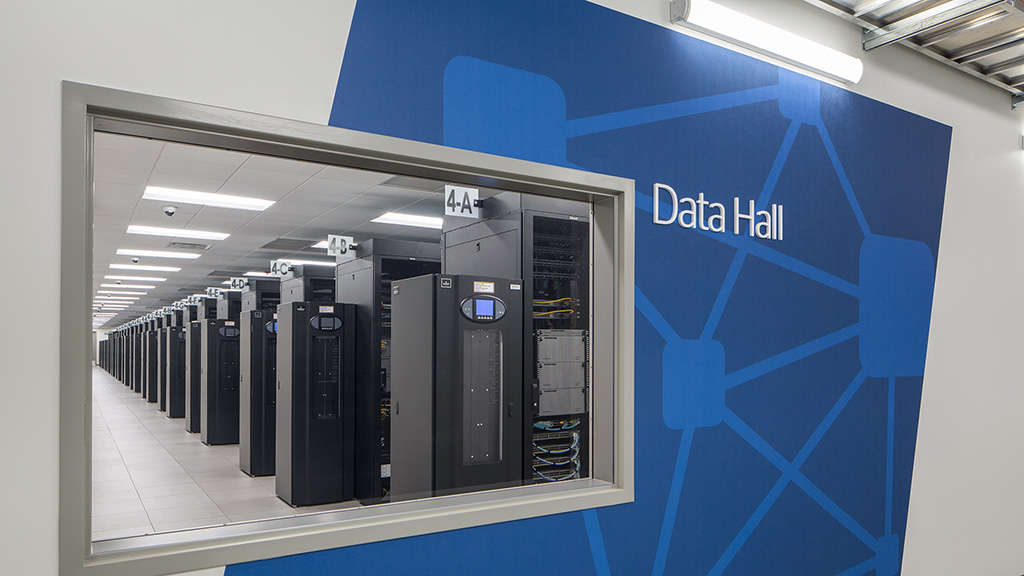Data Keeps Us Going:
How Data Centers Power Society
July 29, 2024 | By Rob LoBuono
It’s hard to imagine a world where you can’t just flip a switch and instantly light up a room. Where you can’t turn a knob and dispense water for morning coffee. Utilities like these have become more than simple conveniences we take for granted. They underpin our every day and make our modern lives possible without a second thought. And in today’s digital age, there’s another force quietly humming behind the scenes: the data center.
Data centers are the unsung workhorse of our information era. While most people understand the concept of data from using their connected devices, many don’t recognize that this data is stored, processed, and distributed from large buildings set up for maximized efficiency and centralized operations. These facilities are filled with row upon row of servers and complex cooling systems, holding the information that drives our businesses, fuels our learning, and connects us to the world. And data has become more than just a convenience in our day-to-day lives. The pandemic served as a stark reminder that access to this utility is the key to innovation and a well-connected future.
The Pandemic Catalyst: Data Keeps Us Going
Before the pandemic, data centers were largely considered a behind-the-scenes necessity for internet companies, financial organizations, and cloud-based tech giants. But the overnight shift to remote work and online learning thrust data into the spotlight. As the whole world scrambled to connect virtually, the critical role of data centers became undeniable. They ensured the uninterrupted flow of information that kept businesses operational, schools functioning, and essential communication accessible. Major aspects of our economy continued, and while our normal lives were thrown into chaos, the digital world powered forward.
The pandemic highlighted several areas in which data centers enrich our society:
- Empowering Workers: Data centers are the foundation for cloud-based applications and services that allow productivity from anywhere with a signal. The raw computing power needed for these tools can only be accomplished via these complex facilities. This benefits businesses through more expansive talent pools and supports workers by offering flexibility and access to employment well outside their home markets.
- Enabling Innovation: From scientific research to AI advancements, data has been driving innovation. The current push for Artificial Intelligence and Large Language Model (LLM) integration into usable solutions is only made possible through data centers. Easy access to such tools can be a huge boost for an emerging company or a community previously isolated from the larger world.
- Enhancing Education: Online learning platforms rely on data centers to manage educational materials, which helps democratize access to knowledge for widely spread-out or underserved communities.
- Supporting Healthcare: Data centers play a crucial role in healthcare by securely storing patient records, facilitating telehealth consultations, and powering medical research not possible through traditional methods.
There’s Never Enough Data
These are just a few examples, but in today’s world, data has become as essential as electricity or water. And much like these utilities at their onset, we are seeing pushback against this building type in some communities. While difficult to imagine, in the previous century there was an active movement against electricity in cities. Until the benefits were fully recognized and the risks were put to bed, some were going as far as calling for an outright ban. Although we do not expect such an extreme a reaction today (since we so easily recognize the benefits of data access), we still contend with NIMBYism and a poor understanding of what these buildings can provide locally if designed and situated properly.
Here are a few examples of data centers’ community benefits:
- Economic growth: A robust IT job market attracts businesses and fosters a thriving digital ecosystem, leading to job creation and economic growth. These buildings require highly technical workers and multiple shifts, due to their complex 24/7 nature. Data centers also provide a high-quality business tax base, which can be used for direct investment into a community.
- Educational and technological advancements: Data center operators often collaborate with local educational institutions, offering training programs for a modern IT workforce and overall technological literacy. This helps foster a skilled and competitive local workforce for the new generation of needs.
- Regional grid stabilization: Data centers improve local electrical grids by investing in advanced power management technologies, integrating renewable energy sources, and encouraging infrastructure upgrades such as transmission lines and substations. These efforts enhance the stability, reliability, and efficiency of local infrastructure, benefiting data centers and surrounding communities.
- Opportunities for small business partnership: As nearly all businesses rely on data for storage, transactions, and website hosting, there is an obvious advantage to reliable access to low-latency connections. Data center proximity offers further advantages of direct server hosting to small businesses in the area.
- Local investment into green energy and water management: Many data center operators have ambitious goals for net-zero power and water use, which requires significant investments into the green power market and onsite water treatment and storage. This helps to supercharge local markets and offset the capital costs to residents for making these upgrades in the future for local climate infrastructure.
Data centers are a major engine driving innovation throughout the global economy. We rely on them more than ever, and in the same way we do with utilities enabling our livelihoods. With annual growth projections for the industry ranging from 10-15% through 2030, according to reports from Goldman Sachs and McKinsey, momentum will continue. In fact, according to a report by JLL, users are expected to generate twice as much data in the next five years than all the data created over the past 10 years.
This unprecedented expansion will require development that is mindful of the legitimate concerns held by impacted communities. It’s our role as architects to provide thoughtful designs and lower environmental footprints, so data centers continue to contribute positively to their surroundings and the world at large. Impactful design is more than just responding to the latest requirements while leveraging past precedent. It involves seeking new opportunities through the expansion of benefits these interconnected buildings bring. By taking an approach that “thinks locally but acts globally” we can ensure that this market succeeds in a way that computes for us all.
For media inquiries, email .

